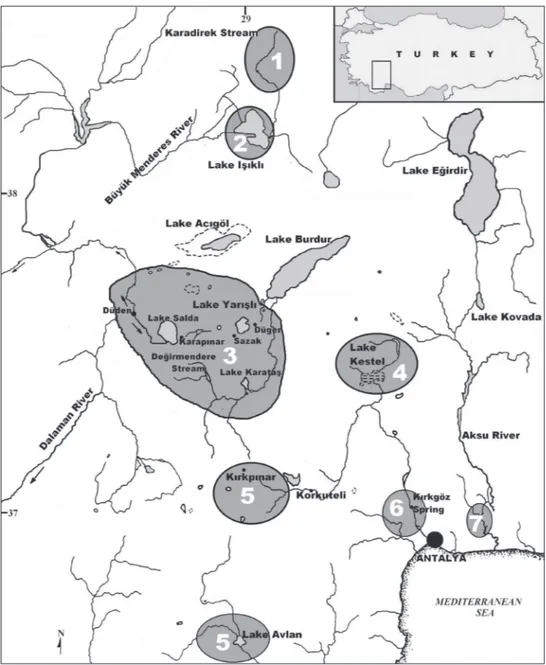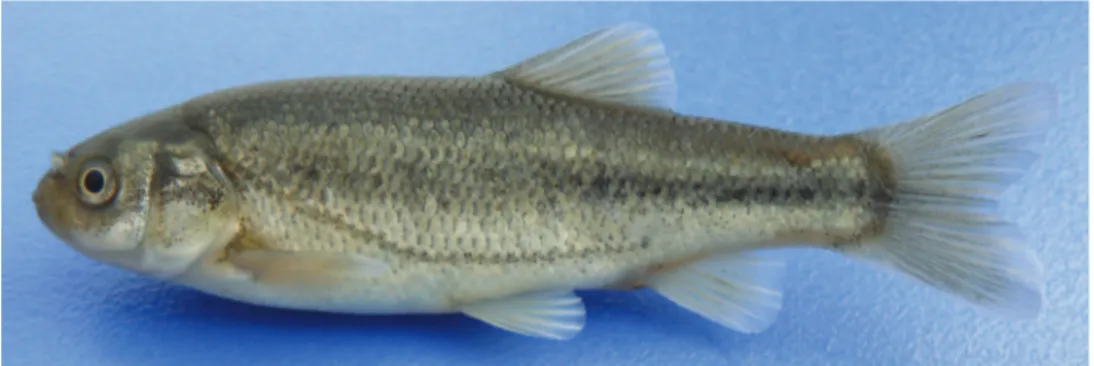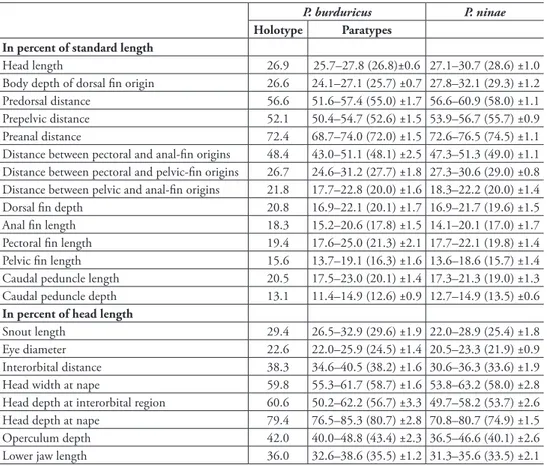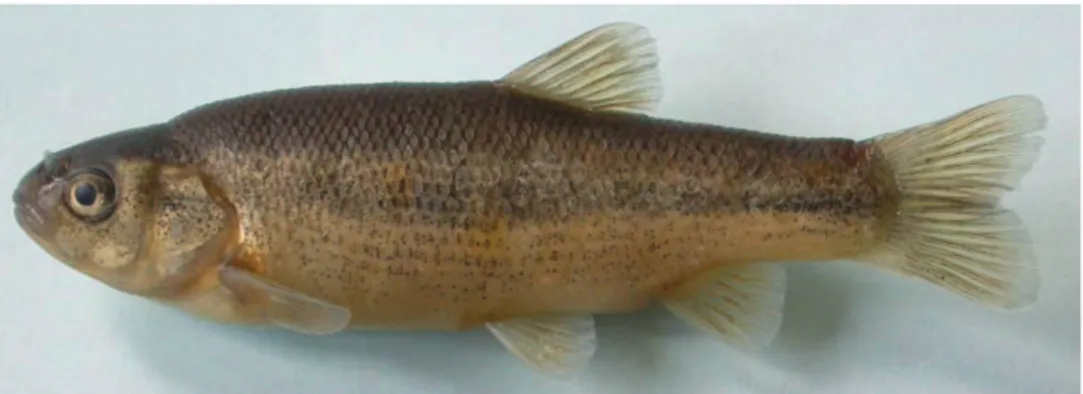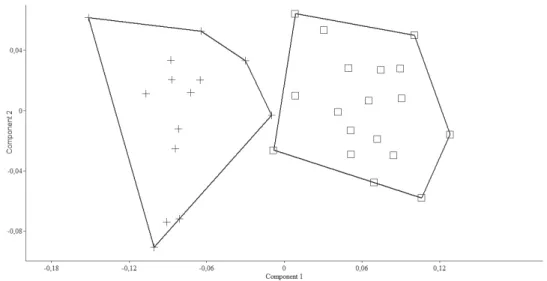Fahrettin Küçük1,†, İskender Gülle2,‡, S. Serkan Güçlü1,§,
Yılmaz Çiftçi3,|, Ömer Erdoğan1,¶
1 Süleyman Demirel University, Eğirdir Fisheries Faculty, Isparta-Turkey 2 Mehmet Akif Ersoy University, Fa-culty of Science and Literature, Biology Department, Burdur-Turkey 3 Ordu University, Fatsa Marine Science Faculty, Fatsa-Ordu-Turkey
† http://zoobank.org/50084B6D-BEF2-4953-B39B-D618AC621473
‡ http://zoobank.org/D0A0B5E8-DF8E-4775-B4E5-84EDC2F4BE5F
§ http://zoobank.org/8198016F-FCF4-4582-91F9-F0E98C5DF567
| http://zoobank.org/20F86C78-9771-422A-948A-424B0BEBABAB
¶ http://zoobank.org/2A9040D4-682F-4F55-8F83-401B2B17929E
Corresponding author: Fahrettin Küçük (fahrettinkucuk@sdu.edu.tr)
Academic editor:N. Bogutskaya | Received 4 December 2012 | Accepted 24 June 2013 | Published 31 July 2013
http://zoobank.org/E1297225-20A1-4814-A0C3-E1CA82A253AE
Citation: Küçük F, Gülle İ, Güçlü SS, Çiftçi Y, Erdoğan Ö (2013) A new Pseudophoxinus (Teleostei, Cyprinidae) species from Southwestern Anatolia, with remarks on the distribution of the genus in western Anatolia. ZooKeys 320: 29–41. doi: 10.3897/zookeys.320.4447
Abstract
Pseudophoxinus burduricussp. n. is described from drainages of Salda and Burdur lakes, southwestern Turkey. It is distinguished from other Anatolian Pseudophoxinus by a combination of characters: lateral line incomplete, with 21–39 (commonly 26–37) perforated scales and 47–57+1-2 scales in lateral series; 10½–12½ scale rows between lateral line and dorsal in origin, 3–4(5) scale rows between lateral line and the pelvic in origin; dorsal in commonly with 7½ branched rays; anal in commonly with 6½ branched rays; 7–8(9) gill rakers on the irst branchial arch; a faint and difuse epidermal black stripe from eye to caudal in base in alive and preserved individuals; mouth slightly subterminal, tip of mouth cleft on about level of lower margin of eye; snout rounded, its length greater than eye diameter. Comparison is given with all Pseudophoxinus species from western Anatolia.
Keywords
Western Anatolia,Cyprinidae, Taxonomy, Pseudophoxinus, new species
introduction
According to Perea et al. (2010), there are 14 distinct clades within Leuciscinae of in-ner waters across the Mediterranean Region, 9 of which being represented in Anatolia. Among these, phylogenies of the genera Petroleuciscus and Pseudophoxinus are most de-bated; indeed even taxonomic status of some Pseudophoxinus species is uncertain. Two well-deined monophyletic clades representAnatolian Pseudophoxinus species: irst of these corresponds to Central Anatolian species complex including P. alii, P. anatolicus, P. antalyae, P. battalgilae, P. crassus, P. elizavetae, P. evliyae, P. fahrettini, P. ninae, and a probable undescribed species; while the other includes Levantine taxa, namely P. irati, P. kervillei, P. zeregi and P. zekayi (Perea et al. 2010). Speciation in Pseudophoxinus is heterogenous, as mentioned by Hrbek et al. (2004) and Bogutskaya et al. (2007), and discrepancies between morphological and molecular relationships can be seen (Perea et al. 2010). Separation of the Pseudophoxinus taxa in Anatolia and western Asia into two groups by Bogutskaya et al. (2007), according to a comparison of morphological parameters (sensory pores, scales and their arrangement on the body, vertebral counts, and supraethmoid bone) with that of the type species P. zeregi is another example of the high degree of variability in the genus.
Morphological and phylogenetic distinctness of P. egridiri (Hrbek et al. 2004: 305), and its closeness to the Pelasgus-Delminichthys lineage (Perea et al. 2010) brings some doubts about monophyly of the Anatolian Pseudophoxinus taxa.
As stated by Hrbek et al. (2002, 2004), Anatolia is an important diversiication cent-er for the genus Pseudophoxinus which shows allopatric speciation especially in basins of Bey Dağları, Büyük Menderes, Tuz Lake and Lakes District. However, the complex taxonomy of the genus in these basins is still unresolved. Although including several lakes and springs of Lakes Region (Lake Salda, Karapınar Spring near Yeşilova district, Düğer Spring, Lake Bahçeözü, Sazak Spring and Kırkpınar Springs) in the distribution area of P. maeandri, Bogutskaya (1992) mentioned that P. maeandri populations from Upper Büyük Menderes basin (Lake Işıklı and Düden Spring near Dinar) morphologically dif-fered from remaining populations in having larger scales and shorter lateral line, fewer lateral series scales and gill rakers on the irst branchial arch, as well as fewer vertebrae.
hus, it was not possible to explain diversiication of Pseudophoxinus in southwestern Anatolia (Fig.1) in its entirety. Furthermore, since its description by Ladiges (1960), suf-icient information on distribution and taxonomy of P. maeandricus has not been given up to date. With regard to the above mentioned morphological and molecular data, it became apparent that the taxonomic position of Pseudophoxinus populations in Burdur and Salda lake basins needed clariication and this led to the present study.
Materials and methods
Fish specimens were caught by pulsed DC electroishing equipment and killed by over anaesthetization, preserved in 5% formalin. Material is deposited in: IFC-ESUF, Inland Fishes Collection, Eğirdir Fisheries Faculty of Süleyman Demirel University. Counts and measurements follow Kottelat and Freyhof (2007), all measurements be-ing point to point made with a digital calliper (0.01 mm sensitive). Standard length (SL) was measured from the tip of the upper lip to the end of the hypural complex. he length of the caudal peduncle was measured from behind the base of the last anal in ray to the end of the hypural complex, at mid-height of the caudal in base. Lateral line scales are counted from the anteriormost scale (the irst one to touch the shoulder girdle) to the posteriormost one. Scales in lateral series are counted along the midlateral line from the irst one to touch the shoulder girdle to the last scale at the end of the hypural complex. Scales on the caudal in itself are indicated by “+” (Freyhof and Özuluğ 2009). he last two branched dorsal and anal in rays articulating on a single pterygiophore were counted as 1½. Vertebral counts were obtained from radiographs and counted as total, predorsal, abdominal and caudal vertebrae following Naseka (1996). Abdominal vertebrae were counted from the irst Weberian vertebra to the one just anterior the irst caudal vertebra. he irst caudal vertebra is that with its haemal spine fully developed. he count of total and caudal vertebrae includes the last complex vertebra bearing hypurals. Osteological charac-ters were examined in cleared and stained with alizarin Red-S specimens and from radiographs (Bogutskaya 1996).
he morphometric characters of the two species of Pseudophoxinus from Turkey were compared by Principal Component Analysis (PCA) using a covariance matrix on log–transformed measurements and counts with the software package PAST version 1.8 (Hammer et al. 2001).
Abbreviations. CSO, supraorbital canal; CIO, infraorbital canal; CPM,
preoper-culo-mandibular canal; HL, lateral head length; SL, standard length. IFC-ESUF, In-land Fishes Collection, Eğirdir Fisheries Faculty of Süleyman Demirel University, Tur-key. IUSHM, Istanbul University, Science Faculty, Hydrobiology Museum, Istanbul.
Results
Pseudophoxinus burduricus sp. n.
http://zoobank.org/5734C2B8-1D58-40E4-ABD6-43A9C610B1AB http://species-id.net/wiki/Pseudophoxinus_burduricus
Figures 2, 3
Holotype. IFC-ESUF 0427, female, 62.80 mm SL; Turkey, Burdur Prov.,
Paratypes. IFC-ESUF 0428, 17 (11 males, 6 females), 39.90–86.69 mm SL; same as holotype.
Additional material. IFC-ESUF 0236, 7, 45.31–54.40 mm SL; Burdur Prov., Salda Stream near Lake Salda; F. Küçük, M.A. Atalay, 13 June 1998. –IFC-ESUF 0289, 3, 31.98–71.56 mm SL, Burdur Prov., Düğer Spring; F. Küçük, A. Altun, M. Telli, 05 August 2006. –IFC-ESUF 0429, 5, 51.34–80.08 mm SL, Burdur Prov., Sazak Spring near Lake Yarışlı; F. Küçük, İ. Gülle, S.S. Güçlü, 13 July 2009.- IFC-ESUF 0430, 6, 41.91–55.95 mm SL, Burdur Prov., Salda Stream near Lake Salda; F. Küçük, İ. Gülle, S.S. Güçlü, 13 December 2009. –IFC-ESUF 0449, 8, 46.10-60.43 mm SL, Burdur Prov.; Salda Stream near Lake Salda; F. Küçük, İ. Gülle, 16 April 2010. –IFC-ESUF 0475, 7, 46.10–60.43 mm SL, Burdur Prov.; Dereköy Stream; F. Küçük, İ. Gülle, S.S. Güçlü. 18 May 2012.
Diagnosis. Pseudophoxinus burduricus is distinguished from all other species of
Anatolian Pseudophoxinus by the following unique combination of characters: head short, its length equal or slightly greater than body depth at dorsal in origin; mouth slightly subterminal, the tip of the mouth cleft on approximately level of with lower margin of eye; snout rounded, its length greater than eye diameter; a faint and difuse epidermal black stripe from eye to caudal in base in alive and preserved individuals; Figure 2. P. burduricus sp. n. IFC-ESUF 0427,holotype, 62.80 mm SL, female; Turkey: Değirmendere Creek, Burdur.
pared ins and caudal peduncle distinctly sexual dimorphic (male with longer pelvic and pectoral ins and slenderer caudal peduncle); lateral line incomplete, with 21–37 (commonly 26–37) perforated scales and 47–57+1-2 scales in lateral series (commonly 50–55); 10½–12½ scale rows between lateral line and dorsal in origin; 3–4 rarely 5 scale rows between lateral line and the pelvic in origin; 7–8 (9) gill rakers on the irst branchial arch; pharyngeal teeth 5–4 or 5–5, slightly serrated and hooked at tip; dorsal in commonly with 7 (8)½ branched rays; anal in with 6 (7)½ branched rays.
Description. See Figs 2–3 for general appearance and Tables 1-2 for
morphomet-ric and meristic data.
A Moderately deep-bodied, elongate and wide headed species. Dorsal proile of body slightly convex in predorsal area, ventral proile more convex than dorsal proile. Predorsal distance 52–57% SL, mean 55.0 and preanal distance 69–74% SL, mean 72.0. Head short, its length 26–28% SL, mean 26.8, approximately 1.0–1.1 times body depth at dorsal-in origin, and its dorsal proile slightly convex on snout. Head depth at interorbital region 2.1–2.7 times eye diameter and 1.3–1.6 times interorbital Table 1. Morphometry of P. burduricus sp.n. (holotype IFC-ESUF 427, paratypes IFC-ESUF 428, n=17) and P. ninae (IFC-ESUF 263, n=15).
P. burduricus P. ninae
Holotype Paratypes
In percent of standard length
Head length 26.9 25.7–27.8 (26.8)±0.6 27.1–30.7 (28.6) ±1.0
Body depth of dorsal in origin 26.6 24.1–27.1 (25.7) ±0.7 27.8–32.1 (29.3) ±1.2 Predorsal distance 56.6 51.6–57.4 (55.0) ±1.7 56.6–60.9 (58.0) ±1.1 Prepelvic distance 52.1 50.4–54.7 (52.6) ±1.5 53.9–56.7 (55.7) ±0.9 Preanal distance 72.4 68.7–74.0 (72.0) ±1.5 72.6–76.5 (74.5) ±1.1 Distance between pectoral and anal-in origins 48.4 43.0–51.1 (48.1) ±2.5 47.3–51.3 (49.0) ±1.1 Distance between pectoral and pelvic-in origins 26.7 24.6–31.2 (27.7) ±1.8 27.3–30.6 (29.0) ±0.8 Distance between pelvic and anal-in origins 21.8 17.7–22.8 (20.0) ±1.6 18.3–22.2 (20.0) ±1.4 Dorsal in depth 20.8 16.9–22.1 (20.1) ±1.7 16.9–21.7 (19.6) ±1.5 Anal in length 18.3 15.2–20.6 (17.8) ±1.5 14.1–20.1 (17.0) ±1.7 Pectoral in length 19.4 17.6–25.0 (21.3) ±2.1 17.7–22.1 (19.8) ±1.4 Pelvic in length 15.6 13.7–19.1 (16.3) ±1.6 13.6–18.6 (15.7) ±1.4 Caudal peduncle length 20.5 17.5–23.0 (20.1) ±1.4 17.3–21.3 (19.0) ±1.3 Caudal peduncle depth 13.1 11.4–14.9 (12.6) ±0.9 12.7–14.9 (13.5) ±0.6
In percent of head length
Snout length 29.4 26.5–32.9 (29.6) ±1.9 22.0–28.9 (25.4) ±1.8
Eye diameter 22.6 22.0–25.9 (24.5) ±1.4 20.5–23.3 (21.9) ±0.9
distance. Mouth slightly subterminal, posterior extremity of upper jaw slightly in front of anterior margin of eye. Snout rounded, its length 27–33% HL, mean 29.6, greater than eye diameter. Caudal peduncle slightly deep, its depth 1.4–1.9, mean 1.6 times in its length.
Lateral line incomplete, usually reaching above anal in origin, 32 perforated scales in the holotype (26–37 in paratypes), 47–57+1-2 scales in lateral series. Dorsal in with 3 simple and 7½ (n=18, in one specimen 8½) branched rays, outer margin slightly convex. Anal in with 3 simple and 6 (15)½ or 7 (3)½ branched rays, outer margin slightly convex. Pectoral in with 13–14 branched rays, outer margin straight or slight-ly convex. Pelvic-in with 7 branched rays. Caudal in forked, lobes rounded. here is no pelvic axillary lobe and keel between posterior pelvic in base and anus. Pharyngeal teeth 5–4 or 5–5, slightly serrated, hooked at tip (developed on the left side). Gill rak-ers short and thick, with 7–8 (9) in outer side of irst gill arch. Preoperculo-mandibular (CPM) and infraorbital (CIO) sensory canals disconnected, CSO with 10–12 pores, CIO with 14–19 pores, CPM with 14–18 pores, total vertebrae 36–39, 21–22 ab-dominal and 15–17 caudal vertebrae, vertebral formulae: 36–39:21–22+15–17.
Sexual dimorphism. In Değirmendere population, there is no tubercules on
snout and head in males, which have longer pelvic and pectoral ins and slender cau-dal peduncles than females. In Lake Salda population, on the other hand, tubercules present in males on entire body (concentrated on operculum) and all ins except for the caudal in.
Coloration. Body silvery, dorsal light brown or olive green and scales irregular
with small epidermal spots in specimenslarger than50 mm SL. here is a faint epider-mal black or violet (in Sazak population) stripe along lateral midline from eye to caudal in base in alive. he dark stripe indistinct or slightly distinct in anterior part of body but distinct in posterior part of body in preserved specimens. Lateral line scales with
P. crassus (*) 65–78 62–73 5–5 40 22 18
P. elizavetea (**) 60–68 33–60 5–5 36–37 (38) 22 14–16
P. evliyae 52–66 16–30 5–4 36–37 21–22 14–16
P. hittitorum 83–96 83–94 5–5 39 21–22 17–18
P. maeandri 41–45 19–27 5–4 35–36 19–20 15–16
P. maeandricus (**) 66–67 58–65 5–5 36–37 20–21 16
P. ninae 46–53 10–32 5–4 36 21 15
small brown to black spots above and below pores in some individuals. Fin membranes whitish or light grey, rays with black-spotted. In individuals smaller than 50 mm SL: body silvery, dorsal dusty grey, ventral pearl grey.
Distribution. Pseudophoxinus burduricus is known only from the lakes and their sources in Lake Burdur Endorheic Basin: Değirmendere Creek, Lake Karataş, Düğer and Sazak (or Kümbet) springs, Dereköy Stream, Lake Salda and Salda Stream (Fig. 1). Değirmendere Creek is a 5 km long creek lowing into the Karamanlı reservoir, which is connected with artiicial reservoir Lake Karataş. Düğer spring is a source of Lake Burdur, while Sazak Spring is a source of Lake Yarışlı. Dereköy Stream is an ap-proximately 5 km long rivulet formerly draining into Çorak (or Akgöl) Lake which, due to a small reservoir constructed in 1970, no more can reach the lake. he new species can be encountered in the shallow parts of the reservoir and the small stream lowing into it.
Other species present were: Chondrostoma fahirae (Ladiges, 1960), Oxynoemacheilus anatolicus Erk’akan, Özeren & Nalbant, 2008 and Oncorhynchus mykiss (Walbaum, 1792) (an escape from ish farms in Karamanlı reservoir)in Değirmendere, in Düğer Spring only O. anatolicus and in Salda Stream only Aphanius splendens (Kosswig & Sözer 1945).
Etymology. he species is named after the Burdur Province where the type
local-ity is located.
Discussion
Hrbek et al. (2004) stated that monophly of Anatolian Pseudophoxinus taxa was not well supported and these represented 6 distinct clades. Of these, Lakes Region popu-lations (Lakes Salda and Karataş, Düğer Spring, Karapınar) identified as P. maeandri formed Clade IV, while the Avlan and Kırkpınar populations identified as P. fahirae (now P. evliyae) formed a separate clade (Clade VI). Perea et al. (2010) mentioned of two well defined monophyletic groups within Anatolian Pseudophoxinus taxa, though not discussion interrelationships of these two. A phylogenetic tree based on the cytb gene sequence, Hrbek et al. (2004: 299) showed presence of two diferent clade; (I) Lake Avlan and Kırkpınar (Lake Söğüt source) populations (P. evliyae) and (II) popula-tions from Burdur and Salda basins.
In this study, we also morphologically compared the new species with Pseudophoxi-nus ninae (the Onaç Stream and Kestel Swamp), P. evliyae (dried Lake Söğüt [Kırkpınar Village, Korkuteli] and source of Lake Avlan [Elmalı]), P. maeandri [Lake Işıklı], P.ma-eandricus (Karadirek Stream [Upper Büyük Menderes basin]), P. alii (Köprüçay and Ilıca Stream), P.battalgilae (Manavgat River basin, Lake Akgöl [Ereğli], Lake Çavuşcu [Ilgın] and Lake Suğla [Seydişehir]), P. fahrettini (Köprüçay River basin [Bağıllı Village and Değirmenözü Stream]), P.antalyae (Kırkgöz Spring, Karamanlı Stream and tribu-taries of Düden canal in Antalya), and P. elizavetae (Sultansazlığı [Kayseri]).
gill rakers in outer side of the irst gill arch (7–8, rarely 9, vs. 8–9) and a longer caudal peduncle (caudal peduncle length 1.4–1.9 times caudal peduncle, vs. 1.3–1.4). It fur-ther difers from P. ninae by having a shorter predorsal distance (52–57% SL, mean 55.0, vs. 57–61, mean 58.0), a shorter preanal distance (69–74% SL, mean 72.0, vs. 73–77, mean 74.5), a somewhat shorter head (head length 26–28 % SL, mean 26.8, vs. 27–31, mean 28.6), and narrower and relatively deeper hyomandibular bone (vs. wide and shallow) (see Figs 5a, b, c). Also Pseudophoxinusburduricus and P. ninae were compared by Principal Component Analysis (PCA). he PCA was performed in us-Figure 4. P. ninae IFC-ESUF 0263, 66.37 mm SL; Turkey: Pınargözü Spring-Bucak.
a b c
ing 18 morphometric characters of the two Pseudophoxinus species. he PCA clearly separated Pseudophoxinusburduricus from P. ninae (Fig. 6). Variables loading on the irst metric PC I–II are given in Table 3.
Preanal length 0.083 0.156 Dist. from pectoral-in origin to anal in 0.060 0.331 Dist. from pectoral-in origin to pelvic in 0.140 0.396
Dist. from pelvic-in origin to anal in 0.012 0.368
Length of caudal peduncle -0.300 -0.383
Depth of caudal peduncle 0.180 0.112
In percent of head length
Snout length -0.445 0.322
Eye diameter -0.285 -0.118
Interorbital distance -0.420 0.166
Head width (at operculum) -0.054 0.300
Head depth (at interorbital region) -0.202 0.080
Operculum depth -0.290 0.155
Head depth operculum -0.208 0.164
Length of lower jaw -0.172 0.164
73–88) and fewer gill rakers in outer side of irst gill arch (7–8, rarely 9, vs. 11–13). Pseudophoxinus burduricus is distinguished P. elizavetae by having fewer scales in the lateral series (47–57+1-2, vs. 56-62+2-3), fewer gill rakers in outer side of irst gill arch (7–8, rarely 9, vs. 11–13).
Comparative material (all from Turkey)
Pseudophoxinus alii: IFC-ESUF 0169, 13 paratyps, 53.33–98.48 mm SL; Antalya Prov.: Ilıca Stream at Manavgat, F. Küçük, 05 May1996.
Pseudophoxinus antalyae: IFC-ESUF 0159, 10, 64.07–97.10 mm SL; Antalya Prov.: Düden Canal, W.V.Neer, F. Küçük, R.Wildekamp, M. Ünlüsayın, 28 July 1996. Pseudophoxinus battalgilae: IFC-ESUF 0161, 18, 46.51-109.68 mm SL; Antalya Prov.:
Oymapınar Dam Lake at Manavgat, F. Küçük, 05 May 1996.
Pseudophoxinus elizavetae: IFC-ESUF 0174b, 10, 49.29-67.47 SL; Kayseri Prov.: Sultansazlığı, M.A. Atalay, 23 August 2004.
25 May 2007.- IFC-ESUF 0268, 1, 73.39 mm SL; Antalya Prov.: Kazanpınarı-Elmalı, F. Küçük, T. Şahan, 25 May 2007.
Pseudophoxinus maeandri: IFC-ESUF 0248, 8, 46.70–55.96 mm SL; Denizli Prov.: Lake Işıklı source, F. Küçük, M.A. Atalay, N. Bogutskaya & A.Naseka, 14 August 2006. Pseudophoxinus maeandricus: 3, 60.71–78.70 mm SL; Afyon Prov.: Karadirek
Stream-Sandıklı, V. Yeğen, 29 June 2006.
Pseudophoxinus ninae: IFC-ESUF 0263, 4, 48.9–67.5 mm SL; Burdur Prov.: Pınargözü-Bucak, F. Küçük, T. Şahan, 25 May 2007. –IUSHM 33900-928, 15, 46.4–68.4 mm SL; Burdur Prov.: Onaç Stream, M. Özuluğ, J. Freyhof, 12 June 2006.
Acknowledgments
his study was supported by the Research Fund of Süleyman Demirel University (grant SDÜ-08.M.1354). he authors thank to Dr. M. Özuluğ (İstanbul Üniversity) and V. Yeğen (Ministry of Food, Agriculture and Livestock) for donating some ish specimens, and Dr. Davut Turan (Recep Tayyip Erdoğan University) and three anonymous re-viewers for commenting on earlier versions of the manuscript.
References
Atalay MA (2005) Pseudophoxinus (Pisces, Cyprinidae) Genusu’nun Anadolu’da Yayılışı ve Taksonomik Özelliklerinin Belirlenmesi (Distribution of the genus Pseudophoxinus (Pi-sces, Cyprinidae) in Anatolia and Determination of its Taxonomic Features. PhD thesis,
Isparta, Turkey: Süleyman Demirel University). [In Turkish]
Bogutskaya NG (1992) A revision of species of the genus Pseudophoxinus (Leuciscinae, Cy-prinidae) from Asia Minor. Mitteilungen aus dem Hamburgischen Zoologischen Museum und Institut 89: 261–290.
Bogutskaya NG (1996) Contribution to the knowledge of leuciscine ishes of Asia Minor. Part 1. Morphology and taxonomic relationships of Leuciscus borysthenicus (Kessler), Leuciscus smyrnaeus Boulenger and Ladigoesocypris ghigii (Gianferrari) (Cyprinidae,Pisces). Publ. es-pec. Inst. Esp. Oceanogr. 21: 25–44.
Bogutskaya NG, Küçük F, Atalay MA (2007) A description of three new species of the genus Pseudophoxinus from Turkey (Teleostei: Cyprinidae: Leuciscinae). Zoosystematica Rossica 15: 335–341.
Freyhof J, Özuluğ M (2009) Pseudophoxinus evliyae,a new species of spring minnow from West-ern Anatolia with remarks on the distribution of P. ninae and the systematic position of P. fahirae (Teleostei: Cyprinidae). Ichthyological Exploration of Freshwaters 20: 309–318. Hammer O, Harper DAT, Ryan PD (2001) PAST: paleontological statistics software package
for education and data analysis, Palaeontologia Electronica 4: 9.
Ladiges W (1960) Süsswasserische der Turkey 1. Teil Cyprinidae. Mitteilungen aus dem Hamburgischen Zoologischen Museum und Institut 58: 105–150.
Naseka AM (1996) Comparative study on vertebral column in the Gobioninae (Cyprinidae, Pisces) with special reference to its systematics. Esp. Oceanogr. 21: 149–167.
